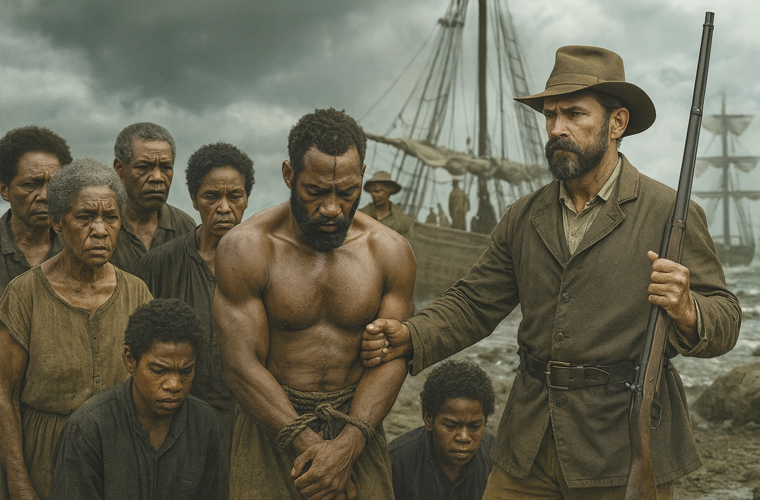The Shadowy Slave Trade of the Pacific
In the sweltering heat of Queensland’s sugarcane fields, a dark chapter of Australian history unfolded—one that echoed the brutalities of the Atlantic slave trade but unfolded across the vast Pacific Ocean. Known as “blackbirding,” this practice involved the coercion, deception, and outright kidnapping of tens of thousands of Pacific Islanders to fuel Australia’s colonial economy. From the 1860s to the early 1900s, over 62,000 men, women, and children—primarily from Melanesian islands like Vanuatu, the Solomon Islands, and Papua New Guinea—were transported to labor on plantations under conditions that many historians now equate to slavery. Though officially termed “indentured labor,” the reality was far grimmer: forced separations from families, rampant disease, and high mortality rates that claimed up to 30% of arrivals. This article uncovers the origins, horrors, and enduring legacy of Australia’s forgotten Pacific slave trade.
Origins: From Caribbean Shadows to Pacific Shores
Blackbirding’s roots trace back to the global slave economy, particularly Britain’s abolished Atlantic trade. After the Slavery Abolition Act of 1833 ended formal slavery in the British Empire, former slave owners and traders, flush with government compensation, turned their eyes southward. Figures like Benjamin Boyd, son of a London slave merchant who shipped thousands of Africans to Caribbean sugar plantations, pioneered the practice in Australia. In 1847, Boyd illegally imported 65 Melanesians from New Caledonia and Vanuatu to work in his whaling operations at Eden, New South Wales—marking the first documented blackbirding voyage.
The trade exploded in the 1860s amid Queensland’s booming sugar industry, which demanded cheap labor after convict transportation ceased in 1840. The schooner Don Juan arrived in Moreton Bay in 1863 with 67 South Sea Islanders from the Loyalty Islands and New Hebrides, destined for cotton plantations. Entrepreneur Robert Towns, inspired by Caribbean models, expanded it further, importing hundreds more via ships like Uncle Tom and Black Dog. Sugar barons, many with direct ties to West Indian slaveholding families—like Louis Hope and the Browns of Antigua Plantation—imported expertise in managing “dark-skinned” workers, embedding racial hierarchies into Australian agriculture. Place names like Habana Plantation (after Cuba’s slave economy) stand as grim reminders of these connections.
Methods: Deception, Violence, and the Lure of False Promises
Recruiters, often called “blackbirders,” employed an arsenal of deceit and brutality. Posing as missionaries with reversed collars and Bibles, they lured villagers aboard with promises of well-paid work or adventure. Others resorted to outright raids: gunpoint kidnappings, village burnings, and even the use of alcohol or phonograph recordings to entice the curious. Children as young as six were taken, comprising up to a quarter of recruits, alongside adolescent males.
Notorious vessels like the Syren (1868) arrived with 24 dead and 90 forcibly taken, while the Carl (1871) saw 60 shot during a recruitment gone awry. Ships were retrofitted like African slavers, with laborers chained in holds and marked with metal discs. Once in Australia, “Kanakas” (a term derived from Hawaiian for “person”) signed three-year contracts they couldn’t comprehend due to language barriers, paid a pittance—often £6 annually, far below European wages—in worthless goods from company stores.
Personal accounts, passed down through generations, paint vivid horrors. Emelda Davis, a descendant, recalls her grandfather’s story: kidnapped at 12 from Tanna, Vanuatu, he was torn from his family and thrust into a world of corporal punishment and segregation.
Scale and Suffering: A Toll in Lives and Labor
The trade’s enormity is staggering: between 1863 and 1907, Queensland alone received 55,000 to 62,500 Islanders from over 80 Pacific locales, including Micronesia and Polynesia. Peak arrivals hit 10,000 annually in the late 1880s, with companies like Burns Philp recruiting up to 530 per month by the 1880s. Labor extended beyond sugar to cotton, coffee, pearling in Western Australia, and even inland sheep stations.
Conditions were lethal. Overwork, malnutrition, and European diseases like tuberculosis ravaged workers; in Maryborough, 443 died between 1875 and 1880—ten times the average rate. Overall, 30% perished during contracts, buried in unmarked mass graves still unearthed today. This mirrored the 33% mortality of enslaved Africans in the Americas, underscoring blackbirding’s slave-like essence.
Resistance, Scandals, and Fleeting Reforms
Islanders fought back fiercely. The 1872 murder of Bishop John Coleridge Patteson sparked international outrage, while the 1880 Sandfly massacre saw five British sailors killed in the Solomons. The 1884 Hopeful scandal—where crew kidnapped and murdered recruits—led to death sentences (later commuted) and a Royal Commission likening the trade to the African slave trade.
Regulations lagged: The Polynesian Labourers Act (1868) mandated licenses, but these were undermined by corrupt agents. British naval patrols, via the Pacific Islanders Protection Acts (1872, 1875), seized ships like the Daphne in 1869 but rarely prosecuted. A temporary ban in 1890 was reversed in 1892, prolonging the misery.
End and Echoes: Deportation and Descendant Struggles
The Pacific Island Labourers Act (1901), cornerstone of the White Australia Policy, halted recruitment after 1904 and ordered deportations by 1906. Of 10,000 remaining, 7,500 were shipped back—often on Burns Philp vessels—using withheld wages from the dead. Around 1,600 to 2,500 stayed via exemptions, forming the Australian South Sea Islander (ASSI) community, now numbering about 20,000 descendants.
Yet the scars persist. ASSI faced century-long discrimination, its history overshadowed by Aboriginal narratives. Official apologies came late: federal recognition in 1994, Queensland in 2000, and Bundaberg’s in 2021, twinning with Vanuatu’s Luganville. Modern parallels loom in seasonal worker schemes, where exploitation echoes blackbirding, prompting the 2018 Modern Slavery Act.
Australia’s blackbirding era built an economic powerhouse—95% of its sugar still from Queensland—but at an unforgivable human cost. As artist Jasmine Togo-Brisby, a fourth-generation descendant, explores in works like Bitter Sweet, confronting this past is key to healing and equity. The Pacific voices stolen for Australia’s gain demand not just remembrance, but reparative justice

